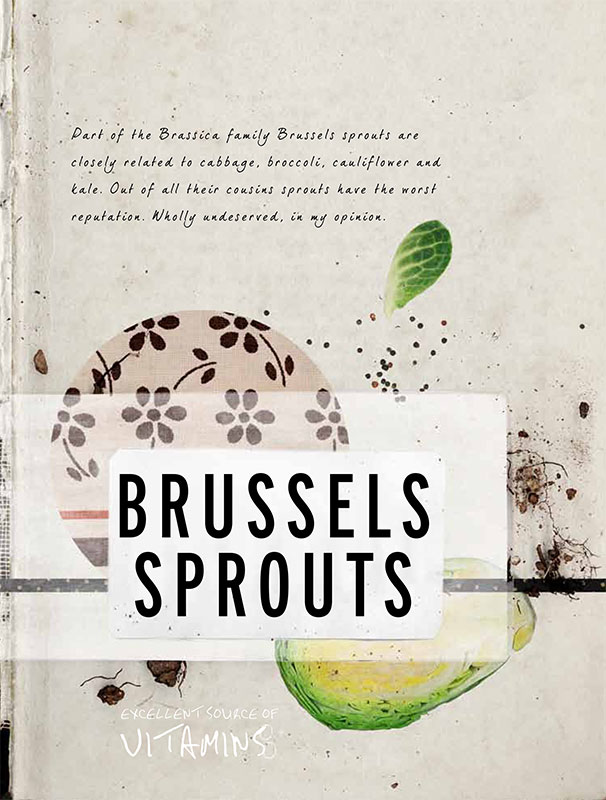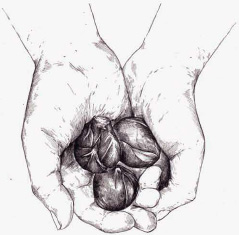
If you have ever seen a Brussels sprout plant growing you would undoubtedly think it was the ugliest, wartiest looking specimen you’ve ever seen, and not something at all edible. You look at its bizarre trunk with countless little green knobs growing from it and think, “God, what is that? It’s a cabbage gone wrong!” And, well, it is.
RECIPES
MASHED BRUSSELS SPROUTS WITH MINT, BEST END OF LAMB
ROASTED BRUSSELS SPROUTS, VANILLA-CONFIT CHESTNUTS & THYME
SALAD OF BRUSSELS SPROUT LEAVES, MOZZARELLA, WHITE ANCHOVIES
So why Brussels sprouts? Well, the obvious answer seems to be “because that’s where they came from,” but there isn’t a lot of evidence to support that statement, although they are popular in Belgium. They probably did originate in Europe and, much like most things, the Romans spread them throughout the continent.
They are a cultivar, or cultivated variety, of the cabbage, which means they were grown and bred from the cabbage specifically for their smaller heads until they became a sub-species in their own right. So there you go. There’s no need to be afraid of the Brussels sprout—they’re just a mini cabbage.
Brussels sprouts are part of the Brassica family and closely related to cabbage, broccoli, cauliflower, kohlrabi and kale. It’s a real “love it” or “hate it” veg, and, out of all its cousins, poor sprouts probably have the worst reputation. And a wholly undeserved one, in my opinion.
It is a beautiful delicate little vegetable, and I have always loved it. I remember Sunday dinner at my nan’s when I was younger (a weekly occurrence) and my sister Lucy getting in trouble every week for getting up from her chair to move the platter of sprouts further away from her. She couldn’t even stand to be near them! I didn’t mind, as long as she moved them closer to me. I think I’d have a dozen for every one Mum made Lucy eat. And my fondness for them has only grown with the ensuing years, as I’ve learned that treating them with a little love and respect will reward you again and again.
I actually do blame the moms, dads, pops and nans of this world for completely cooking the life out of Brussels sprouts, bastardizing them so that the entire house smells, well, there really is no delicate way to put this, it smells like farts. My nan was one of the guilty parties, believe me. It didn’t put me off sprouts, though, but I will readily admit that she would boil them on high heat for at least an hour before serving so that they resembled waterlogged gray walnuts, with not a single thing gorgeous or green left about them. Certainly, they didn’t retain any of the vitamins or minerals that sprouts are naturally endowed with—these would have all gone down the drain. In fact, these little beauties are vitamin powerhouses, they’re high in protein and anti-oxidants and can be described with all those other buzzwords that equal “good for you.” But that is only if they are cooked correctly. So let me tell you how, and believe me, it is this simple …
Never, never, never cook them all the way through. Cook them until just al dente—that is, still with a little bite to them, then take them off the heat immediately as they will carry on cooking. By the time you dress them, either with a little olive oil or butter and some salt and pepper, and get them on the table, they will be just perfect for eating.
Their flavor is so delicate and sweet, yet so robust. They make a classic accompaniment when paired with chestnuts, thyme, mint and bacon.
There are a few other ways I like to cook them for a good result. You can finely chop the sprouts and cook them in lightly salted boiling water. Meanwhile, heat some butter until foaming and toss the drained sprouts through. Season and eat straight away. Cutting them finely reduces the cooking time.
I also enjoy peeling the individual leaves from the head. Discard any discolored or straggly outer ones and use the lovely tender inner leaves. Just lightly blanch them in boiling water and refresh under cold water. This will take away the “plasticky” coating on the outside of the leaves but they will retain their lovely raw, crunchy texture, much like cabbage. This is one of my favorite sides.
As I mentioned, the Brussels sprout plant is a weird-looking one, but strangely beautiful in its own way. It is also really great to grow, and ideally suited for small spaces as it grows straight up. It will take quite some time to mature, about 3–6 months, like most members of the Brassica family, but you should enjoy a yield of about 2 pounds 4 ounces of sprouts per plant.

MASHED BRUSSELS SPROUTS WITH MINT, BEST END OF LAMB
SERVES 4
This is the clincher. If you have been in the “don’t go near Brussels sprouts” school then this will convert you. I personally love them, and this is my fail-safe recipe to cooking them well—the mint and vinegar help soften the flavor of the sprouts and I couldn’t think of anything better to serve them with than a roasted best end of lamb.
2 POUNDS 4 OUNCES-2 POUNDS 10 OUNCES BEST END OF LAMB (SEE NOTE)
OLIVE OIL, FOR SEARING
12 BRUSSELS SPROUTS
1 GENEROUS TABLESPOON OLIVE OIL
1 GENEROUS TABLESPOON CHARDONNAY VINEGAR
1 BIG PINCH OF MINT LEAVES, THINLY SLICED
FINE SEA SALT AND FRESHLY GROUND BLACK PEPPER
Preheat the oven to 425°F. Heat the olive oil in a large skillet over high heat for 1 minute. Sear the lamb on all sides until a nice caramelized brown color, about 4 minutes all up, then transfer to a roasting tray and place in the oven for 35–45 minutes. Remove from the oven and allow to rest, then carve into slices to serve.
Meanwhile, trim the bases of the Brussels sprouts, peel off the outer dark green leaves and quarter. Place the sprouts in a 8-cup capacity saucepan, cover with water and bring to a boil, then turn down to a simmer and cook for 10–13 minutes. Immediately drain, then add the sprouts back to the pan and place over low heat. You want to dry the sprouts out a little for 1–2 minutes. Take off the heat and mash roughly 8–10 times with an old-school hand-held masher. Now stir in the olive oil, vinegar and mint, season with salt and pepper and serve with the lamb.
Note Best of lamb is an old English cut of meat. It’s the best part of the neck and shoulder with 4 racks (or points) attached.
ROASTED BRUSSELS SPROUTS, VANILLA-CONFIT CHESTNUTS & THYME
SERVES 4 AS A SIDE
Remember that Brussels sprouts are delicious until they’re overcooked. Then they emanate a farty smell and will taste like how the grans of the past cooked them. Follow this recipe to the “T” and I assure you that you will love the Brussels.
7 OUNCES SWEET CHESTNUTS
¾ CUP VANILLA SYRUP (SEE RECIPE)
20–30 BRUSSELS SPROUTS
3 TABLESPOONS OLIVE OIL
SEA SALT AND FRESHLY GROUND BLACK PEPPER
2 TABLESPOONS BUTTER, DICED
5 SPRIGS THYME, LEAVES PICKED AND FINELY CHOPPED
Preheat the oven to 425°F. Score the top of the chestnuts with a sharp knife, place on a baking sheet and bake for 5 minutes or until they start to split open at the cut. Cool slightly, then peel while still warm.
Turn down the oven to 400°F. Place the peeled chestnuts and vanilla syrup in a small saucepan (4 inches in diameter) and bring to a boil, then turn down the heat to low and simmer for 15–17 minutes. Set aside.
Trim the bases of the Brussels sprouts, peel off the outer dark green leaves and halve. (You can either throw the outer leaves away or have a go at making the salad of Brussels sprout leaves, mozzarella, white anchovies). Heat a large skillet over high heat. Add the olive oil and warm for 1 minute, then add the sprouts, cut side down, and sauté for 4 minutes. Drain the chestnuts from the syrup with a slotted spoon and add to the pan. (Discard the syrup or save to use again.) Season with salt and pepper, add the butter and thyme and once the butter has melted, give it a good stir. Pour into a large ovenproof serving dish and roast for 12–15 minutes. Serve straight away.
SALAD OF BRUSSELS SPROUT LEAVES, MOZZARELLA, WHITE ANCHOVIES
SERVES 2 AS AN ENTRÉE OR AS A SIDE SALAD TO SHARE
You just wouldn’t know how delicious Brussels sprouts leaves in a salad are until you actually eat them in this way. This recipe can be adapted—use all sorts of delicious things you like.
2 TABLESPOONS WALNUTS
4⅓ OUNCES BRUSSELS SPROUT LEAVES (THE OUTER LEAVES, NOT THE INNER TOUGHER ONES)
½ CUP PICKED WATERCRESS
1 TEASPOON HONEY
1½ TABLESPOONS RED WINE VINEGAR
3 TABLESPOONS EXTRA VIRGIN OLIVE OIL
2 TABLESPOONS CURRANTS, SOAKED IN WARM WATER FOR 5 MINUTES, THEN DRAINED
8–12 WHITE ANCHOVY FILLETS
2 SHALLOTS, THINLY SLICED
1 SMALL (ABOUT 4 OUNCE) BUFFALO MOZZARELLA BALL, CUT INTO 8 SLICES
6 BASIL LEAVES, TORN
2 TABLESPOONS FINELY CHOPPED ITALIAN PARSLEY
SEA SALT AND FRESHLY GROUND BLACK PEPPER
CRUSTY FRENCH BAGUETTE, TORN, TO SERVE
Preheat the oven to 350°F. Place the walnuts on a baking sheet and roast for 3–5 minutes or until fragrant. Allow to cool slightly, then roughly chop and set aside.
Bring a saucepan of salted water to the boil. Add the sprout leaves, allow to come back to the boil and cook for 1 minute. Drain, then refresh under cold water. Pat the leaves dry and place in a large bowl with the watercress.
Place the honey in a small saucepan over low heat, add the vinegar, bring to a boil, then add the olive oil and take off the heat. Stir in the currants and walnuts and set aside. This is the dressing for the whole dish.
Add the anchovies and shallots to the sprout leaves and dress with a little of the dressing. Place the mozzarella onto plates, arrange the sprout mixture around the mozzarella, dress with a little more of the dressing, then scatter over the herbs. Finish with salt and pepper. Serve with the bread to mop the dressing up with.